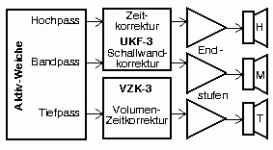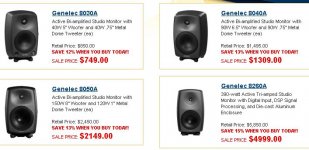The VC heating thing typically comes up when active and passive x-os are compared. Hear the call, "the transfer function doesn't change with an active crossover because it is not affected by VC Z". Well, that is actually a load. First, that assumes the amp's output Z is negligible and, even if that is the case, it is in reference to the VOLTAGE transfer function. Second, the force accelerating the driver is dependent on the CURRENT through the VC. As most realize, I = V/Z. So, holding V constant while Z changes due to heating means the response still chances as the VC heats even if the voltage transfer function remains constant. It is interesting that, for example, with a second order passive topology the increase in driver Z typically increases Q of the filter, raising the voltage applied around the corner frequency. This actually help keep the current through the VC more constant.
I'm not stating that either result is ideal, just that it is not all that simple. VC heating raises Re, but has little effect on Le so the details of how Ze changes are a lot more complex than is typically discussed.
I'm not stating that either result is ideal, just that it is not all that simple. VC heating raises Re, but has little effect on Le so the details of how Ze changes are a lot more complex than is typically discussed.
Last edited:
I don't see that passive xovers are 'cut only'. In each of my last 3 speaker designs, there are frequency regions where I have obtained up to 15 db of boost, and without dropping the impedance to unrealistic levels.
How did you manage to do that? Sounds like a resonant tank circuit
Rob
Could you imagine a 7.1 fully active setup. What a nightmare.
Simplicity should always be one of the design goals.
Sure, just use some of these for the side and rear surround speakers:
Synergy - 18dB/oct Active Bi-Amp Kit by AmpsLab
That's a handy looking amp board!
Still, you'd have to have one of those + a transformer, fuse and power cord for every speaker. Doable, but is it worth it?
I use active speakers in the pro world everyday (since '97) Meyer, JBL, EV. Would never go back to the old way. But for home use?
Still, you'd have to have one of those + a transformer, fuse and power cord for every speaker. Doable, but is it worth it?
I use active speakers in the pro world everyday (since '97) Meyer, JBL, EV. Would never go back to the old way. But for home use?
And how does this Synergy thingie take woofer and tweeter SPL's, baffle step etc. into consideration?
Contrary to the ideas ventilated by some here, the design of a properly functioning active filter is a very difficult task. Do have a look at the LEAP tutorials, even with decent drivers the circuit tends to become rather complex.
If the woofer peaks, which is very often the case, gyrators must be included.
So much for textbook active filters.
Regards,
Eelco
Contrary to the ideas ventilated by some here, the design of a properly functioning active filter is a very difficult task. Do have a look at the LEAP tutorials, even with decent drivers the circuit tends to become rather complex.
If the woofer peaks, which is very often the case, gyrators must be included.
So much for textbook active filters.
Regards,
Eelco
Sure, just use some of these for the side and rear surround speakers:
Synergy - 18dB/oct Active Bi-Amp Kit by AmpsLab
That's pretty cool, but I'd have to have 4 of them, plus 4 power supplies. I suppose the easiest way to do it might be to have one single beefcake power supply and use 4 pole Speakon carrying line level plus power, unless that's a terrible idea for noise and hum and such.
Of course, the other trouble is the horrible cringe of loathing when a typical audiophile sees 10 cent alps pots and zero discrete circuitry. I won't declare my position on that issue publicly as nothing good will come of it.
Also, I've noticed now that I've started looking around for a new HT receiver that does the new formats is a lot of them don't offer pre-outs anymore, which would mean active was out of the question, unless you go for something like an Emotiva UMC-1, which doesn't do 3d just yet.
Yeah, it starts to become impractical as well as expensive. For the less than the cost of those modules and transformers, you could put your hands on a Marantz SR5006 receiver. It's all done for you there. Not DIY, but maybe a more sane choice.
I'm with ya there, especially when you figure in the Audessey EQ stuff, the end result is bound to be better.
And how does this Synergy thingie take woofer and tweeter SPL's, baffle step etc. into consideration?
it probably doesn't
I have seen THEL(Germany) has some active curcuit options for that, but not cheap
Attachments
Thanks for the interest in the Synergy.
What separates the Synergy from the rest is the precision of the crossover and the transparency of the system. The transparency aspect is vital and the most difficult to achieve. In designing the Synergy, it is mandatory that the electronic crossover is more transparent than my passive ones. Otherwise, there's no reason to use active.
The Synergy has no provisions for BSC. All contouring, BSC and EQs are done passively. This is in adherence to my philosophy of keeping the electronics to an absolute minimum.
A good comparison would be the Genelec. Think of the Synergy as the active system within.
What separates the Synergy from the rest is the precision of the crossover and the transparency of the system. The transparency aspect is vital and the most difficult to achieve. In designing the Synergy, it is mandatory that the electronic crossover is more transparent than my passive ones. Otherwise, there's no reason to use active.
The Synergy has no provisions for BSC. All contouring, BSC and EQs are done passively. This is in adherence to my philosophy of keeping the electronics to an absolute minimum.
A good comparison would be the Genelec. Think of the Synergy as the active system within.
Attachments
Last edited:
Dear Michael,
I do not want to sound too harsh, but having built 300+ loudspeakers and well over a dozen amps over 35 years. I ve read most literature including Toole and Cordell, but do unfortunately not know what -other than a marketing term- transparancy of a crossover is.
Could you elaborate please?
Kind Regards,
Eelco
I do not want to sound too harsh, but having built 300+ loudspeakers and well over a dozen amps over 35 years. I ve read most literature including Toole and Cordell, but do unfortunately not know what -other than a marketing term- transparancy of a crossover is.
Could you elaborate please?
Kind Regards,
Eelco
The LM3886 power amp chips are the one's Linkwitz uses in his Pluto bi-amped speaker system. Apparently having the whole amp circuit in a chip allows for much better bias tracking over temperature in the class AB output stage, and thereby minimizes crossover distortion that feedback has a hard time eliminating. The only significant shortcoming I know of with that chip is the max power out.
There are those who think they can hear the difference between a $2 polypropylene cap in a passive crossover, and a $35 polypropylene cap. And then in the coils department, it's got to be ultra heavy gauge flat ribbon wire, possibly made out of pure silver, formed at some ridiculous temperature measured in kelvin degrees, to make them happy. I'm guessing that that's what they mean by "transparency". It's designed so you can easily see where their money goes.Dear Michael,
I do not want to sound too harsh, but having built 300+ loudspeakers and well over a dozen amps over 35 years. I ve read most literature including Toole and Cordell, but do unfortunately not know what -other than a marketing term- transparancy of a crossover is.
Could you elaborate please?
Kind Regards,
Eelco
My wallet will stay opaque at $79 for an amp/crossover kit. But that's not the point of this thread, is it?
I think it's highly relevant to this thread. If certain people are only happy using boutique components then that's possibly a good reason that could make active make more sense. Smaller components cost far far less for the boutique versions (that's if you consider a 1% polystyrene cap as boutique).
Thanks for the interest in the Synergy.
Michael,
While we have you here... why the limited range of XO points. This would be a neat package for some frugal-phile 2-ways but i'd need XO in the 200-400 Hz.
dave
- Status
- This old topic is closed. If you want to reopen this topic, contact a moderator using the "Report Post" button.
- Home
- Loudspeakers
- Multi-Way
- What do you think of passive crossovers?

